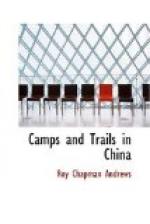While we were talking Wu appeared to guide us to the camp. They had chosen a beautiful temple with a flower-filled courtyard on the summit of a hill overlooking the city. It was wonderfully clean and when our beds, tables, and chairs were spread on the broad stone porch it seemed like a real home.
The next days were busy ones for us all, Roy and Heller setting traps, and I working at my photography. We let it be known that we would pay well for specimens, and there was an almost uninterrupted procession of men and boys carrying long sticks, on which were strung frogs, rats, toads, and snakes. They would simply beam with triumph and enthusiasm. Our fame spread and more came, bringing the most ridiculous tame things—pigeons, maltese cats, dogs, white rabbits, caged birds, and I even believe we might have purchased a girl baby or two, for mothers stood about with little brown kiddies on their backs as though they really would like to offer them to us but hardly dared.
The temple priest was a good looking, smooth-faced chap, and hidden under his coat he brought dozens of skins. I believe that his religious vows did not allow him to handle animals—openly—and so he would beckon Roy into the darkness of the temple with a most mysterious air, and would extract all sorts of things from his sleeves just like a sleight-of-hand performer. He was a rich man when we left!
The people are mostly tribesmen—Mosos, Lolos, Tibetans, and many others. The girls wear their hair “bobbed off” in front and with a long plait in back. They wash their hair once—on their wedding day—and then it is wrapped up in turbans for the rest of their lives. The Tibetan women dress their hair in dozens of tiny braids, but I don’t believe there is any authority that they ever wash it, or themselves either.
Li-chiang was our first collecting camp and we never had a better one. On the morning after our arrival Heller found mammals in half his traps, and in the afternoon we each put out a line of forty traps which brought us fifty mammals of eleven species. This was a wonderful relief after the many days of travel through country devoid of animal life.
Our traps contained shrews of two species, meadow voles, Asiatic white-footed mice, spiny mice, rats, squirrels, and tree shrews. The small mammals were exceedingly abundant and easy to catch, but after the first day we began to have difficulty with the natives who stole our traps. We usually marked them with a bit of cotton, and the boys would follow an entire line down a hedge, taking every one. Sometimes they even brought specimens to us for sale which we knew had been caught in our stolen traps!




